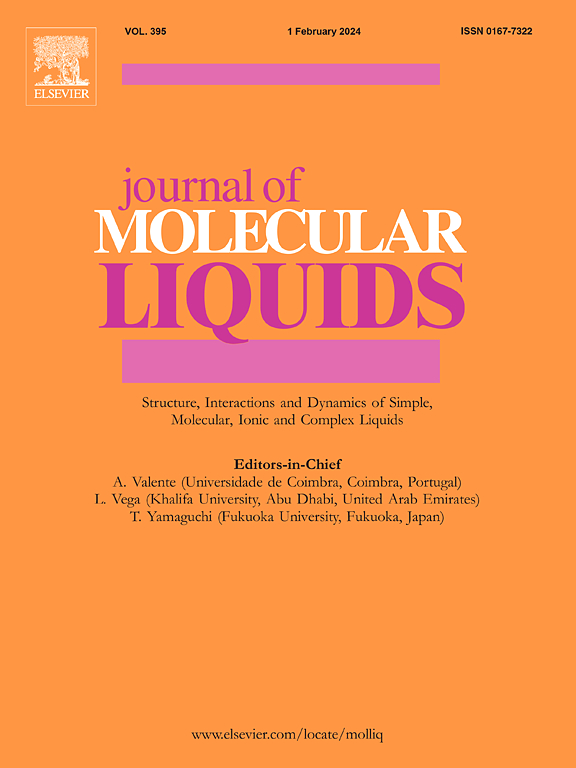Chitosan/clay adsorbent for dye removal: Statistical mechanics and thermodynamic insights
IF 5.3
2区 化学
Q2 CHEMISTRY, PHYSICAL
引用次数: 0
Abstract
The efficient removal of dyes from aqueous effluents still lacks studies that explore the adsorption mechanisms involved, especially in systems with oppositely charged dyes. This study investigates the equilibrium adsorption behavior of Methylene Blue and Acid Red 27 dyes on a chitosan/clay composite from a statistical mechanics perspective, aiming to identify differences in the removal mechanisms. Five statistical mechanics models were evaluated to identify differences in the interaction mechanisms between the adsorbent and the dyes. The models consider different numbers of layers and adsorption energies. The monolayer model with a single energy best described the experimental data for both dyes. The maximum experimental adsorption capacities were 513.98 mg g−1 for Methylene Blue (pH 10) and 349.29 mg g−1 for Acid Red 27 (pH 2) at 298 K and 250 min. The number of molecules adsorbed per site was greater than 1, indicating multimolecular mechanisms. The process was favored at low temperatures and characterized as physical adsorption, with adsorption energies lower than 40 kJ mol−1, indicating that the mechanism occurs via electrostatic interaction and hydrogen bonds. Although they present similar removal mechanisms, the composite demonstrated a greater affinity for methylene blue, evidenced by its lower half-saturation concentration (4.79 mg L−1) and higher adsorption energy (28 kJ mol−1), compared to Acid red 27 (8.01 mg L−1 and 22 kJ mol−1, respectively). The results show the selectivity of the composite for cationic dyes and demonstrate the usefulness of statistical mechanics as a robust tool for interpreting adsorption mechanisms in hybrid adsorbents.

壳聚糖/粘土吸附剂去除染料:统计力学和热力学见解
有效去除水中的染料仍然缺乏研究,探索所涉及的吸附机制,特别是在具有相反电荷染料的系统中。本文从统计力学的角度研究了亚甲基蓝和酸性红27染料在壳聚糖/粘土复合材料上的平衡吸附行为,旨在找出其去除机制的差异。评估了五种统计力学模型,以确定吸附剂和染料之间相互作用机制的差异。模型考虑了不同的层数和吸附能。具有单一能量的单层模型最好地描述了两种染料的实验数据。在298 K和250 min条件下,亚甲基蓝(pH 10)和酸红27 (pH 2)的最大吸附量分别为513.98 mg g−1和349.29 mg g−1,每个位点的吸附分子数大于1,表明其多分子吸附机制。吸附能低于40 kJ mol−1,表明吸附机理是通过静电相互作用和氢键形成的。虽然它们具有相似的去除机制,但与Acid red 27(分别为8.01 mg L−1和22 kJ mol−1)相比,该复合材料具有更低的半饱和浓度(4.79 mg L−1)和更高的吸附能(28 kJ mol−1),对亚甲基蓝具有更大的亲和力。结果表明,复合材料对阳离子染料具有选择性,并证明了统计力学作为解释杂化吸附剂吸附机理的有力工具的有效性。
本文章由计算机程序翻译,如有差异,请以英文原文为准。
求助全文
约1分钟内获得全文
求助全文
来源期刊

Journal of Molecular Liquids
化学-物理:原子、分子和化学物理
CiteScore
10.30
自引率
16.70%
发文量
2597
审稿时长
78 days
期刊介绍:
The journal includes papers in the following areas:
– Simple organic liquids and mixtures
– Ionic liquids
– Surfactant solutions (including micelles and vesicles) and liquid interfaces
– Colloidal solutions and nanoparticles
– Thermotropic and lyotropic liquid crystals
– Ferrofluids
– Water, aqueous solutions and other hydrogen-bonded liquids
– Lubricants, polymer solutions and melts
– Molten metals and salts
– Phase transitions and critical phenomena in liquids and confined fluids
– Self assembly in complex liquids.– Biomolecules in solution
The emphasis is on the molecular (or microscopic) understanding of particular liquids or liquid systems, especially concerning structure, dynamics and intermolecular forces. The experimental techniques used may include:
– Conventional spectroscopy (mid-IR and far-IR, Raman, NMR, etc.)
– Non-linear optics and time resolved spectroscopy (psec, fsec, asec, ISRS, etc.)
– Light scattering (Rayleigh, Brillouin, PCS, etc.)
– Dielectric relaxation
– X-ray and neutron scattering and diffraction.
Experimental studies, computer simulations (MD or MC) and analytical theory will be considered for publication; papers just reporting experimental results that do not contribute to the understanding of the fundamentals of molecular and ionic liquids will not be accepted. Only papers of a non-routine nature and advancing the field will be considered for publication.
 求助内容:
求助内容: 应助结果提醒方式:
应助结果提醒方式:


